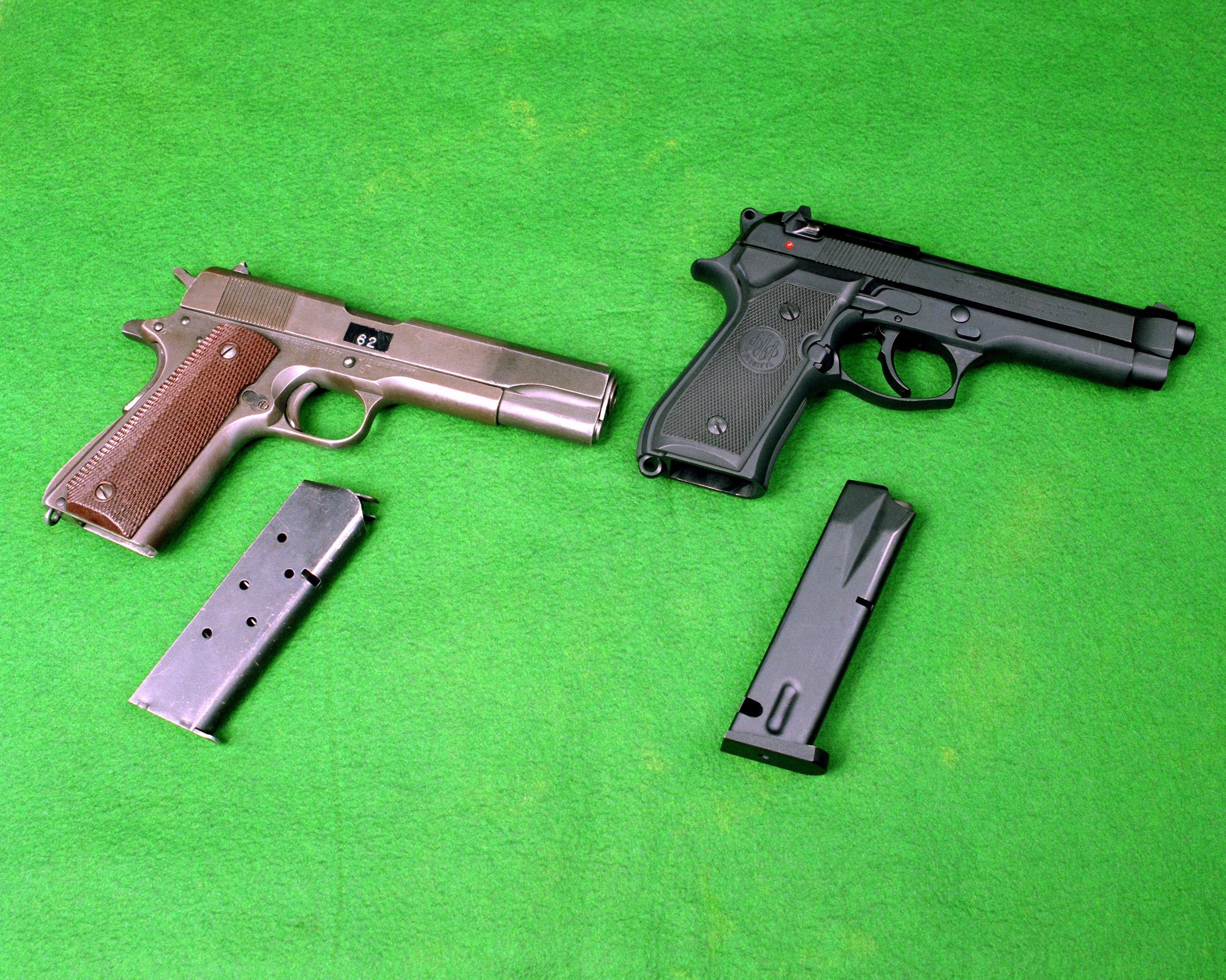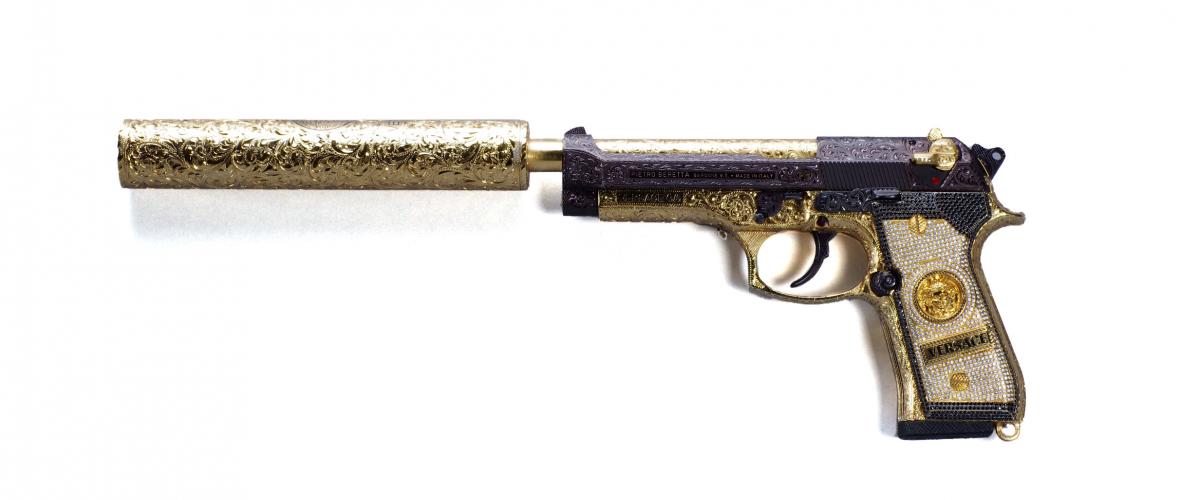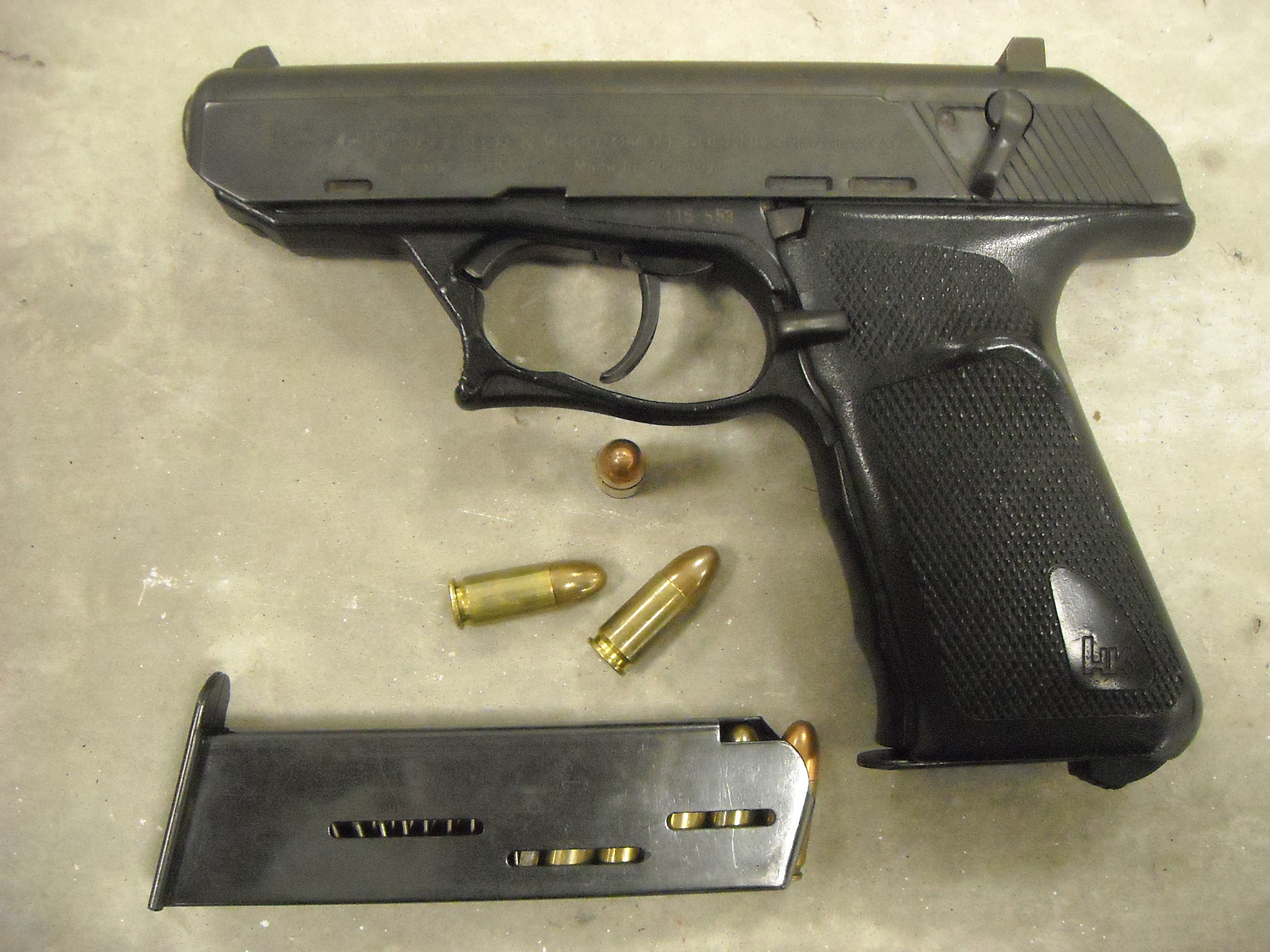|
Joint Service Small Arms Program
The Joint Service Small Arms Program, abbreviated JSSAP, was created to coordinate weapon standardization between the various United States armed service branches. Prelude In 1962, the Air Force adopted the Smith & Wesson Model 15 revolver over the M1911A1. By 1977 their inventory was wearing out, and the USAF requested special ammunition for the M15 to improve its effectiveness due to malfunctions it suffered. A Congressional investigation revealed that the USAF had 25 different handguns in inventory. Congressman Addabbo from New York said, "The current proliferation of handguns and handgun ammunition in Air Force inventory is intolerable." Congress encouraged DOD to select a standard handgun and phase out all others. This task was assigned to the newly created Joint Service Small Arms Program (JSSAP). The United States Military forces had been using a variety of different small arms which grew over the years to about ten different types of handguns. Models in use ... [...More Info...] [...Related Items...] OR: [Wikipedia] [Google] [Baidu] |
9×19mm Parabellum
The 9×19mm Parabellum (also known as 9mm Luger, 9mm NATO or simply 9mm) is a Rim (firearms)#Rimless, rimless, Centerfire ammunition, centerfire, tapered cartridge (firearms), firearms cartridge. Originally designed by Austrian firearm designer Georg Luger in 1901, it is widely considered the most popular handgun and submachine gun cartridge due to its low cost, adequate stopping power and extensive availability. Since the cartridge was designed for the Luger pistol, Luger semi-automatic pistol, it has been given the designation of ''9mm Luger'' by the Sporting Arms and Ammunition Manufacturers' Institute (SAAMI) and the (CIP). A 2007 US survey concluded that "about 60 percent of the firearms in use by police are 9mm [Parabellum]" and credited 9×19mm Parabellum pistol sales with making semiautomatic pistols more popular than revolvers.Adler, Jerry, et al. (30 April 2007)"Story of a Gun"(). ''Newsweek'' 149.18: 36–39. MasterFILE Premier. EBSCO. Dallas Public Library, Dallas, ... [...More Info...] [...Related Items...] OR: [Wikipedia] [Google] [Baidu] |
Beretta M9
The Beretta M9, officially the Pistol, Semiautomatic, 9mm, M9, is the designation for the Beretta 92FS semi-automatic pistol used by the United States Armed Forces. The M9 was adopted by the United States military as their service pistol in 1985. The 92FS won a competition in the 1980s to replace the M1911A1 as the primary sidearm of the U.S. military, beating many other contenders and only narrowly defeating the SIG Sauer P226 for cost reasons. It officially entered service in 1990. Some other pistols have been adopted to a lesser extent, namely the SIG P228 pistol, and other models remain in limited use. The M9 was scheduled to be replaced under a United States Army program, the ''Future Handgun System'' (FHS), which was merged with the ''SOF Combat Pistol'' program to create the '' Joint Combat Pistol'' (JCP). The JCP was renamed ''Combat Pistol'' (CP), and the number of pistols to be bought was drastically cut back. The U.S. Army, Navy, Air Force, and Marine Corps are ... [...More Info...] [...Related Items...] OR: [Wikipedia] [Google] [Baidu] |
Beretta 92SB-F
The Beretta 92 (also Beretta 96 and Beretta 98) is a series of semi-automatic pistols designed and manufactured by Beretta of Italy. History Carlo Beretta, Giuseppe Mazzetti and Vittorio Valle, all experienced firearms designers, contributed to the final design in 1975. The Beretta 92 was designed in 1975, and production began in 1976. Many variants in several calibers continue to be used to the present. Evolution 92 Production began in May 1976, and ended in February 1983. Approximately 7,000 units were of the first "step slide" design and 45,000 were of the second "straight slide" type. 92S In order to meet the requirements of some law enforcement agencies, Beretta modified the Beretta 92 by adding a slide-mounted combined safety and decocking lever, replacing the frame-mounted manual thumb safety. This resulted in the 92S, which was adopted by several Italian law enforcement and military units. The magazine release button is at the bottom of the grip as is customary in E ... [...More Info...] [...Related Items...] OR: [Wikipedia] [Google] [Baidu] |
Heckler & Koch P9
The HK P9 is a semi-automatic pistol from Heckler & Koch in 9×19mm Parabellum, .45 ACP, and 7.65×21mm Parabellum and the first to use a variation of H&K's roller delayed blowback system in a pistol format and polygonal rifling now common in H&K designs. Design The P9 is a roller-delayed pistol manufactured from a stamped steel main frame and a polymer trigger guard. The stamped steel slide contains machined internal parts including a polygonally rifled barrel. High-profile fixed sights are fitted with two red rectangles on the rear sight and a white stripe on the drift adjustable front blade sight. Vertical zeroing is accomplished by fitting front sights of a different height. The P9S trigger operates as a traditional double action. There is a lever on the left side of the pistol grip to both decock a cocked hammer or to manually re-cock it for a single action first shot, a feature first observed on the Sauer 38H. A further function of the decocking lever is to releas ... [...More Info...] [...Related Items...] OR: [Wikipedia] [Google] [Baidu] |
Beretta 92
The Beretta 92 (also Beretta 96 and Beretta 98) is a series of semi-automatic pistols designed and manufactured by Beretta of Italy. History Carlo Beretta, Giuseppe Mazzetti and Vittorio Valle, all experienced firearms designers, contributed to the final design in 1975. The Beretta 92 was designed in 1975, and production began in 1976. Many variants in several calibers continue to be used to the present. Evolution 92 Production began in May 1976, and ended in February 1983. Approximately 7,000 units were of the first "step slide" design and 45,000 were of the second "straight slide" type. 92S In order to meet the requirements of some law enforcement agencies, Beretta modified the Beretta 92 by adding a slide-mounted combined safety and decocking lever, replacing the frame-mounted manual thumb safety. This resulted in the 92S, which was adopted by several Italian law enforcement and military units. The magazine release button is at the bottom of the grip as is customary in E ... [...More Info...] [...Related Items...] OR: [Wikipedia] [Google] [Baidu] |
Smith & Wesson M15
The Smith & Wesson Model 15, initially the Smith & Wesson K-38 Combat Masterpiece, is a six-shot double-action revolver with adjustable open sights produced by Smith & Wesson on the medium-size "K" frame. It is chambered for the .38 Special cartridge and is fitted with a barrel, though additional barrel options have been offered at various times during its production. It is essentially a shorter barrel version of the Smith & Wesson Model 14 and an adjustable-sight version of the seminal Smith & Wesson Model 10 with target shooting features. The Model 15 was introduced in 1949 as the K-38 Combat Masterpiece. It was renamed the Model 15 in 1957, when all Smith & Wesson revolvers were given numerical model numbers. The Model 15's main production run lasted 50 years until 1999, when it was discontinued for approximately a decade, with only brief limited runs in the Heritage Series line. In 2011, a retooled Model 15 was re-released under the Classics Revolvers line, remaining in prod ... [...More Info...] [...Related Items...] OR: [Wikipedia] [Google] [Baidu] |
Star Model 28
Star Model 28 – also written as Star M28 – is a 9×19mm semi-automatic pistol produced by Star Bonifacio Echeverria. The Star Model 30, Star Model 31 and their variants are considered part of the same design family as Star Model 28. Prior to Model 28, Star mostly focused on modifications of other platforms, namely of Colt M1911. Star Model 28 marks the first original design from Star Firearms. In 1977 the United States Air Force solicited manufacturers for a 9mm Handgun to replace their Smith & Wesson Model 15 .38 Special revolvers. The Star Model 28 was submitted for testing and evaluation. However the Beretta 92F was eventually selected and adopted in 1985 as a result of the Joint Service Small Arms Program. Design Star Model 28 is one of the early double-column double action pistols and can be thus identified as a wondernine type of pistol Star 28/30/31 are all recoil operated, locked breech pistols, that use Browning-designed, linkless locking (like Browning Hi-Power ... [...More Info...] [...Related Items...] OR: [Wikipedia] [Google] [Baidu] |
Star Bonifacio Echeverria
Star Bonifacio Echeverria, S.A. was a manufacturer of small arms (principally pistol caliber firearms such as handguns and submachine guns) in the Basque region of Spain from about 1905 until 1997. Company history Bonifacio Echeverria and the ancestry of Star The Eibar region has been a center of weapons development and manufacture for centuries, with "Spanish Steel" historically being a selling point with its reputation for quality and durability. When firearms came into being, Eibar retained its edge as a weapons manufacturing center. The oldest known ancestor of the Star lineage is José Cruz Echeverria, who made muzzle-loading firearms in the 19th century. His two sons, Julián and Bonifacio, entered the firearms business about 1905. Thanks to a curious mechanism in the Spanish patent law, local firms were until 1986 free to produce foreign designs protected abroad if they weren't produced in Spain. So the brothers started to make the model 1908 pistol, substantially an un ... [...More Info...] [...Related Items...] OR: [Wikipedia] [Google] [Baidu] |
Smith & Wesson 459
The Smith & Wesson 459 is a 9mm double/single action pistol with locked breech short recoil action. It is an updated version of the Model 59 with adjustable sights and checkered nylon grips. The gun was created for the US XM9 Pistol trials. This handgun did not complete the test and so was not considered. Testing procedures are discussed in the book ''Future Weapons''. and also aFirearms Radio XM9 Testing This model was discontinued in 1988. 803 units were produced in a brush finish with special grips made to FBI specifications. Users * ** Federal Bureau of Investigation The Federal Bureau of Investigation (FBI) is the domestic Intelligence agency, intelligence and Security agency, security service of the United States and Federal law enforcement in the United States, its principal federal law enforcement ag ... About 800 handguns issued to Agents. References {{Smith & Wesson Trial and research firearms of the United States 9mm Parabellum semi-automatic pist ... [...More Info...] [...Related Items...] OR: [Wikipedia] [Google] [Baidu] |
Smith & Wesson
Smith & Wesson Brands, Inc. (S&W) is an American Firearms manufacturer, firearm manufacturer headquartered in Maryville, Tennessee, United States. Smith & Wesson was founded by Horace Smith (inventor), Horace Smith and Daniel B. Wesson as the "Smith & Wesson Revolver Company" in 1856, after their previous company, also called the "Smith & Wesson Company" and later renamed as "Volcanic Repeating Arms", was sold to Oliver Winchester and became the Winchester Repeating Arms Company. The modern Smith & Wesson had been previously owned by Bangor Punta and Tomkins plc before being acquired by Saf-T-Hammer Corporation in 2001. Smith & Wesson was a unit of American Outdoor Brands Corporation from 2016 to 2020 until the company was Corporate spin-off, spun out in 2020. History Volcanic Repeating Arms Horace Smith (inventor), Horace Smith and Daniel B. Wesson founded the Smith & Wesson Company in Norwich, Connecticut in 1852 to develop the Volcanic rifle. Smith developed a new Volcani ... [...More Info...] [...Related Items...] OR: [Wikipedia] [Google] [Baidu] |
Heckler & Koch VP70
The VP70 is a 9×19mm, 18-round, double action only, semi-automatic/three-round burst capable polymer frame pistol manufactured by German arms firm Heckler & Koch GmbH. VP stands for ''Volkspistole'' (literally "People's Pistol"), and the designation 70 was for the first year of production, 1970. Design The VP70 combined a number of design features that were innovative, or at least very unusual for its time: * It was the first polymer- framed handgun, predating the Glock 17 by 12 years. At unloaded, the weapon is lighter than most metal framed pistols of the time. * It has a double-stack, double-feed magazine; double-feed magazines are uncommon for pistols even today. These magazines hold 18 rounds, a rather high capacity for its original production time. * As on the Mauser C96 and the Lahti L35, the stock was designed to be used as a holster when not mounted. On the military version of the VP70 this combination includes a unique feature: when mounted, a selective-fire sw ... [...More Info...] [...Related Items...] OR: [Wikipedia] [Google] [Baidu] |






